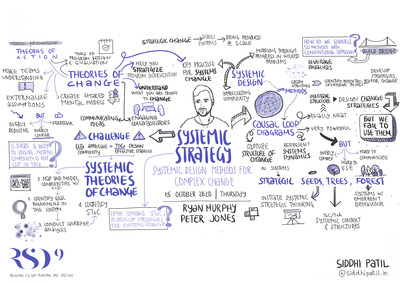Systemic Strategy: Systemic design methods for complex systems change
Murphy, Ryan J. A. and Jones, Peter (2020) Systemic Strategy: Systemic design methods for complex systems change. In: Proceedings of Relating Systems Thinking and Design (RSD9) 2020 Symposium., 9-17 Oct 2020, Ahmedabad, India.
Preview |
Text
Murphy_Systemic_RSD9_paper_2020.pdf Available under License Creative Commons Attribution Non-commercial No Derivatives. Download (55kB) | Preview |
![Murphy_Systemic_img_2020.png [thumbnail of Murphy_Systemic_img_2020.png]](https://openresearch.ocadu.ca/3691/2.hassmallThumbnailVersion/Murphy_Systemic_img_2020.png)  Preview |
Image
Murphy_Systemic_img_2020.png Available under License Creative Commons Attribution Non-commercial No Derivatives. Download (1MB) | Preview |
Preview |
Text
Murphy_Systemic_Slides_2020.pdf Available under License Creative Commons Attribution Non-commercial No Derivatives. Download (11MB) | Preview |
Abstract
Systemic design is a key practice for systems change (Jones, 2017). Systems change is a transdiscipline (Brown, Harris, & Russell, 2010) that focuses on fostering strategic changes across systems to bring about positive social gains at scale (Gopal & Kania, 2015). Many foundations (”Systems Change,” 2020), philanthropists (Walker, 2017), investors (”Systems Change: An Emerging Practice in Impact Investing,” 2019), NGOs (Banerjee et al., 2019), and governments (OECD, 2017) have taken an interest in systems change work in recent years. Systemic designers wield many tools and mindsets that support understanding and designing for effective interventions in complex systems (Jones, 2014). In this paper, we bridge the gap between a conventional tool of social change programming (Theories of Change) and systemic design methodologies in a combined approach for the design and evaluation of systemic strategies.
Theories of Change (ToCs; and Theories of Action, ToAs) are conventional and fundamental tools in program design and evaluation (Mackinnon, 2006). These tools make explicit a team’s understanding of the system they are working within, externalize assumptions and biases, and help teams create shared mental models about the ways their change strategies should work (”Theory of Change: A Practical Tool,” 2004). They are commonly used in the design and development of change interventions, as they help develop and engage collaborators in a common mental model of the problem and potential solutions (Abercrombie, Boswell, & Thomasoo, 2018, p. 5).
However, ToCs can also be reductive (Abercrombie et al., 2018, p. 5). They are usually linear and compact, able to be shared on a single slide or a single figure in a funding proposal. Systemic design principles suggest that this simple linearity is problematic: models that are so simple likely represent an idealized vision of the system, ignorant of the counterintuitive complexities that make these systems so hard to change.
We argue that while ToCs have their role in communicating core ideas about a system and convincing funders to invest in an initiative, they should not be used to drive systems change strategy decisions. Such strategies will at best be flawed and fail; at worst, change initiatives using too-reductive a model may exacerbate the problems they aim to solve when they fail to account for system feedbacks (Abercrombie et al., 2018, p. 5). Systemic design offers alternative tools for would-be users of theories of change, such as Causal Loop Diagrams (CLDs; Kim, 1992). However, these tools are sometimes too complex, making it difficult to come to a consensus about what to do in a system.
Ergo, both ToCs and CLDs are important tools for systems change. ToCs and their counterpart, ToAs, provide a framework for quickly and concretely explaining the narrative of systems change. CLDs help designers understand the complex system they’re working within and identify opportunities for change.
In a recent paper, we propose a novel approach that bridges ToCs and systemic design in the creation of Systemic Theories of Change (SToCs; Murphy & Jones, 2020). There, we demonstrated that tools like leverage analysis—based on analyses of causal loop diagrams (Kim, 1992)—can help designers break down the complexity of systems models. Program designers and evaluators can use these tools to embrace complex systems dynamics, rather than ignore them.
In this paper, we build upon those methods, bridging SToCs with strategic planning. Through a strategy “seeds,” trees,” and “forest” metaphor, we show how SToCs can be converted to conventional strategies and aligned with strategy maps (Kaplan & Norton, 2000), how multiple SToCs can be brought together to create holistic systems change strategies, and finally how systemic designers can establish and manage comprehensive monitoring and evaluation assessments of whether their systemic strategies are working. We demonstrate these concepts via a case study. Our ultimate aim is to converge the important work of program design and evaluation with the principles and methods of systemic design, enabling systems change strategies to be simultaneously more effective and understandable.
| Item Type: | Conference/Workshop Item (Paper) |
|---|---|
| Divisions: | Faculty of Design |
| Date Deposited: | 09 May 2022 20:23 |
| Last Modified: | 09 May 2022 20:30 |
| URI: | https://openresearch.ocadu.ca/id/eprint/3691 |
Actions (login required)
 |
Edit View |

 Lists
Lists Lists
Lists